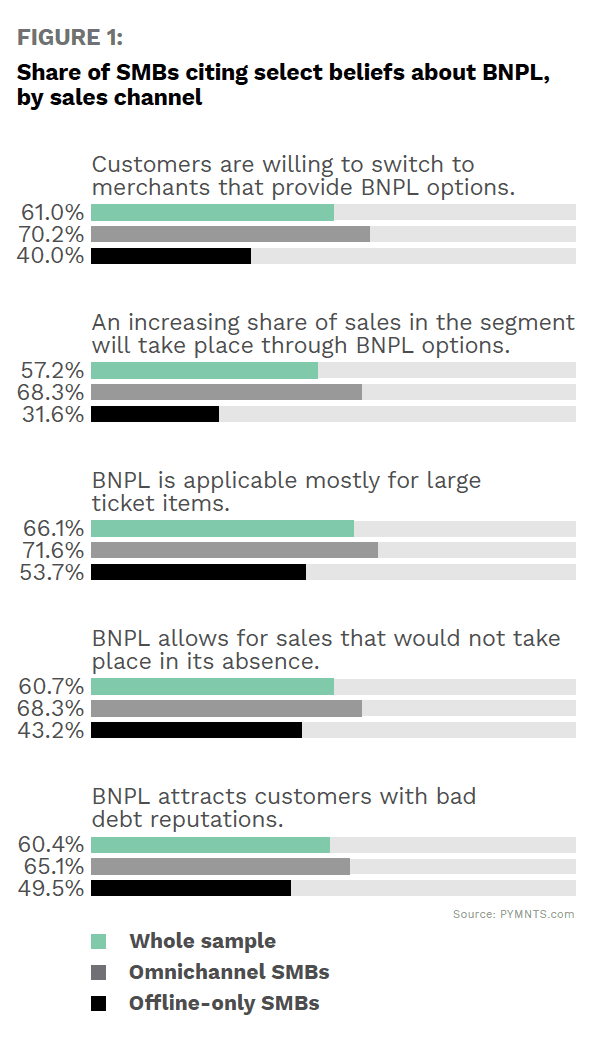Buy now, pay later (BNPL) solutions’ increasingly mainstream place in the payments ecosystem has big implications for merchants.
One survey found that 48% of U.S. consumers already have used BNPL and that 51% are more interested in this payment option than they were one year ago. Installment payment plans are gaining popularity not only for online purchases, but also for in-person shopping. A separate study found that 56% of in-store consumers accepted a BNPL payment option offered to them during checkout, compared to 51% of online shoppers.
Efforts by payments giants — including American Express, Square and Visa — to increase their BNPL footprints also illustrate the growing recognition that BNPL offers value beyond its basic function as a payment method. Leading BNPL players even can bring merchants new customers and create significant opportunities to drive additional sales. They also provide their partners with extensive data and help increase consumer trust during the purchasing process. Merchants should therefore view BNPL as an integrated marketing and payments solution rather than simply a convenient way for customers to pay for purchases.
This month’s Deep Dive examines how BNPL solutions promote and boost traffic as well as expand merchants’ data and analytics capabilities. It also analyzes new PYMNTS data showing that most small- to medium-sized businesses (SMBs) believe that BNPL is key to driving sales.
BNPL Drives Traffic to Merchant Partners and Serves as Stamp of Approval
Marketing represents a core part of the value that BNPL solutions deliver to merchants. Major BNPL providers have built extensive networks of retailers — with Afterpay listing almost 100,000 global partners prior to its acquisition by Square, for example — that serve as merchant curation platforms.
This serves as something of a stamp of approval for in-network businesses, granting them credibility and trust with BNPL users.
Installment payment plan providers can also directly promote their partners in various ways. The typical BNPL-to-merchant traffic funnel involves deals, offers and other calls to action presented to customers via the BNPL provider’s mobile app, promotional emails and other forms of direct customer interaction. These offerings are powered by BNPL firms’ consumer data and analytics capabilities, which can generate highly targeted customer-specific offers.
BNPL players can use social media and special events to increase traffic to their partners. Afterpay’s 2021 “Afterpay Day” sale, for example, generated roughly 6 million referrals for merchants through its Shop Directory feature, with 30% of this traffic going to SMBs. The company also launched a TikTok campaign with Crocs in 2020 that received nearly 7 billion views and achieved an 18.5% engagement rate. Direct collaborations with individual merchants represent another important way BNPL players boost traffic and brand awareness for their partners. Afterpay also recently debuted Afterpay Ads, which allows merchants to run ads directly on the company’s mobile app. These various initiatives illustrate just a few of the ways in which BNPL providers can drive traffic to participating merchants.
Merchants Can Leverage Data and Analytics Insights From BNPL Providers
The vast amount of customer and transaction data available to BNPL providers can pair with advanced analytical capabilities, also enabling them to generate deep insights into customer behavior that ultimately benefit their partners. Geoff Seeley, chief marketing officer at Afterpay, recently noted that BNPL providers not only know what their customers are buying but also know which customers are buying which products. This, he explained, allows merchant partners to capitalize on insights into purchasing trends. These revelations also can be used to help merchants prioritize their supply chains and execute on inventory decisions.
Direct access to data and analytics is becoming a more prominent feature of the BNPL value proposition to merchants. Afterpay also recently announced that it will launch a new merchant analytics platform called Afterpay iQ to provide its partners with analytics and data-driven insights, for example. The artificial intelligence (AI)-powered platform aims to analyze a merchant’s operations by demographic, channel, physical store location and other parameters to produce specific insights geared toward increasing sales and profitability.
Most Omnichannel SMBs Believe Customers Are Willing to Switch to Merchants That Provide BNPL
Marketing and data-focused BNPL innovations are likely to see an eager reception among merchants, particularly SMBs. A new PYMNTS survey of omnichannel and brick-and-mortar SMBs revealed that most believe BNPL plays a significant role in driving sales. Sixty-one percent of respondents said their customers are willing to switch to merchants that offer BNPL solutions, in fact, and 57% said BNPL will account for an increasing share of sales. Sixty-one percent said BNPL facilitates sales that otherwise would not be completed. Seventy percent of omnichannel merchants agreed that consumers are willing to switch to merchants that offer BNPL, as do just 40% of offline-only firms.
The survey data also pinpointed two key issues BNPL players should address in their messaging. The first is that 60% of respondents said BNPL attracts customers with bad debt reputations, a mistaken viewpoint that could deter a fair share from offering BNPL. A second misconception is that BNPL is applicable mostly for large-ticket items, an opinion held by about two-thirds of the SMBs surveyed.
The survey spotlights an untapped opportunity for outreach by BNPL providers to SMB merchants, especially omnichannel merchants. They may perceive costs, hassles or other barriers that are discouraging them from climbing on board with BNPL, despite its clear advantages in payment flexibility, data insight capabilities and marketing potential. The BNPL players that can crack the code on SMB outreach will see their market shares surge within the segment.


